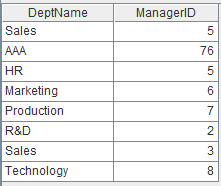T. modify()
Description:
Modify field values in a table sequence.
Syntax:
|
T.modify(k,xi:Fi,…) |
Modify the kth record, which is equal to T(k).modify(xi:Fi,…) . |
|
T.modify(k:A,xi:Fi,…) |
Modify the records from the kth record to the (k+|A|-1)th record. |
Note:
The function modifies one or more records at the specified position(s). Automatically update the index, if any, and check distinctness.
Parameter:
|
k |
The position at which the record will be modified. If k exceeds the limit, then append a new record in the end. |
|
xi |
The value of Fi field to be modified. |
|
Fi |
Name of the field of the record which will be modified. If Fi is omitted, then modify the ith field of T. |
|
T |
A table sequence. |
|
A |
A sequence or an integer; If A is an integer, then it is equal to to(A) . |
Option:
|
@n |
Return the newly-modified record or sequence. |
|
@r(k:A) |
Modify table sequence T using sequence A from the kth record according to the order of the fields. |
|
@f(k:A) |
Modify table sequence T using sequence A from the kth record; only the common fields are modified. |
Return value:
Return the updated record or sequence
Example:
|
|
A |
|
||
|
1 |
=demo.query("select * from DEPARTMENT") |
|
||
|
2 |
=A1.modify(1,"Sales",5) |
Modify the first and the second fields of the first record.
|
||
|
3 |
=A1.modify(2,6:MANAGER) |
Modify the MANAGER field of the second record.
|
||
|
4 |
=A1.modify@n(2:1,"AAA":DEPT,76:MANAGER) |
Return the modified second record.
|
||
|
5 |
=create(DeptName,ManagerID) |
|
||
|
6 |
=A5.modify(1:A1,DEPT:DeptName,MANAGER:ManagerID) |
Append a new record in the end because 1 exceeds the limit.
|
||
|
7 |
=A1.delete(A1.select(MANAGER>5)) |
|
||
|
8 |
=A5.modify@r(1:A7) |
Modify A5 using A7 from the first record. |
||
|
9 |
=create(DeptName,MANAGER) |
|
||
|
10 |
=A9.modify@f(1:A7) |
Modify MANAGER field only.
|
Related function:




